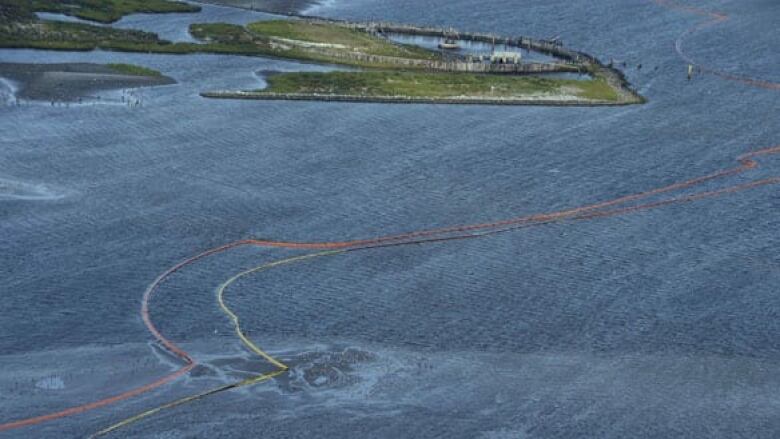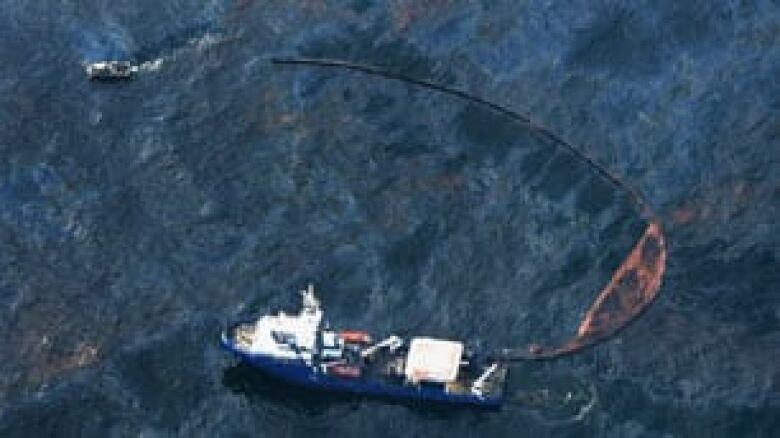Massive oil spill hits U.S. coast
Louisiana declares state of emergency

A massive and growing oil leak in the Gulf of Mexico began to lap atLouisiana's coastline on Thursday night, with moredark gooexpected to move in by Friday.
Louisiana Gov. Bobby Jindal said the oil was expected to be propelled by strong southeast winds, would likelyhammer Louisiana untilTuesdayand would be carried ashore by higher-than-normal tides.
"Neither one of those are good factors for Louisiana's coast," he said.
YOUR ASSIGNMENT
Gulf Coast oil spill:Tell us your story
"It is of grave concern," David Kennedy of the U.S. National Oceanic and Atmospheric Administration said. "I am frightened. This is a very, very big thing. And the efforts that are going to be required to do anything about it, especially if it continues on, are just mind-boggling."
The oil slick could become theworst U.S.environmental disaster in decades, threatening hundreds of species of fish, birds and other wildlife along the Gulf Coast, one of the world's richest seafood grounds, teeming with shrimp, oysters and other marine life.
The U.S. Coast Guard was working with BP, the company that operated the oil rig that exploded and sank last week, to deploy floating booms, skimmers and chemical dispersants on the water, and to set controlled fires to burn the oil off thesea's surface.
BP said it is considering using a chemical to break up the oil underwater, a technique that has never been tried before at these depths. The leaking wellhead is 1,500 metres below the water's surface.
Jindal'sdeclaration of a state of emergency paves the way for federal intervention and assistance, including additional booms from the coast guard that will help protect coasts and fisheries.
Obamasays BP will pay
U.S. President Barack Obama saidearlier his administration will use "every single available resource at our disposal" to deal with the spill. Obama said that could include using the military in the response.
The presidentsaidBP, which was operating the Deepwater Horizon oil rig when it exploded and sank last week triggering the leak, will ultimately carry the cost of the cleanup.
U.S. Homeland Security Secretary Janet Napolitano, Interior Secretary Ken Salazar and the Environmental Protection Agency's administrator, Lisa Jackson, will travel to the Gulf Coast on Friday tolook atcleanup operations.
Napolitano declared Thursday the spill was"of national significance."
"This means we can draw down assets from across the country" and centralize communications, Napolitanosaid, making a rare appearance at a White Housenews briefing Thursday afternoon.
"We are being very aggressive and we are prepared for the worst case," coast guard Rear Adm. Sally Brice-O'Hara said at the White House.
Federal officials announced inspections would begin immediately of all oil rigs in the Gulf and subpoena powers would be used in the gathering investigation. But the priority was to support BP to fight the oil surging from the seabed.
Spill more massive than thought
BP officials acknowledged Thursday morning that the spill may be five times larger than originally believed.
The leak began after thedeepwater rig operated by BPexploded and burned on April 20.

Early estimates said 1,000 barrels a day were leaking from the drilling site of the coast of Louisiana.
But on Wednesday, the U.S. National Oceanic and Atmospheric Administration revised that to 5,000 barrels, a number BP's chief operating officer, Doug Suttles denied vehemently at a news conference late Wednesday night.
By Thursday morning, Suttles had reversed his stance.
"We can now say it's probably more than 1,000," Suttles told Matt Lauer on NBC's Today."It's within the range. I would say the range is from one to 5,000 barrels a day.
"That 1,000 barrels a day was the best estimate at the time."
Fishing industry mobilized
BP has not said if or whenit can stop the leak and keepthe rest of the oilfrom washing up onshore.
"We continue to focus on ensuring that [the oil] doesn't [reach the coast]," BP CEO Tony Hayward told CNN on Wednesday.
"I can tell you we'll do everything, absolutely everything to [stop the leak] as soon as possible," Suttles said Thursday.
"We'll take help from anyone."
The spill has put Louisiana's seafood industry on high alert. With $1.8 billion in salesannually, it is the largest industry of its kind in the lower 48 states.
"We're all concerned," Harlon Pierce, the chair of the Louisiana Seafood Promotion and Marketing Board, told CBC News from New Orleans. "If it was a 10-gallon spill we would be equally concerned and equally as motivated to solve the problem.
"One-third of the growing area for seafood in the entire United States is off the coast of Louisiana. So protection of this area to me is as important or more important than anything else."
Time of the essence
Pierce said fishing fleets have been mobilized to helpthe cleanup effort.
BP crews on Wednesday conducted a controlled burn on parts of the oil spill a technique designed to remove large amounts of oil from open water.
As of Wednesday, it had also deployed 16 large skimming vessels to remove oil from the water's surface and 288,000 litres of dispersants, BP said on its website, and hadrecovered 16,311 barrels of oil-water mix.
BP was to set more fires after the test, but as night fell, there were no more burns.
Crews planned to use hand-held flares to set fire to sections of the spill. They turned to the idea after failing to stop the leak at the spot where theoil drillingplatform exploded on April 20 and later sank.
Eleven workers are missing and presumed dead and more than 100 escaped the blast, the cause of which has not been determined.
If the leaking wellhead cannot be closedwithin the three months it would take to drill a relief well to alleviate the pressure,it could eclipse the worst oil spill in U.S. history, the 41.6 million litresthat poured into Alaska's Prince William Sound in 1989 as a result of the Exxon Valdez disaster.
With files from The Associated Press












_(720p).jpg)


 OFFICIAL HD MUSIC VIDEO.jpg)
.jpg)



























































































